Evolution of Violin Bow Hold
Why do we hold the violin bow the way we do today?
The way you hold and move the bow is of great influence on your sound, technique and expression
Discover different bow grips in this historical overview of how the violin bow hold developed throughout the centuries
In the bow hold every finger has a different job. This technique has developed since the existence of the violin from the 16th century until the modern violin bow hold.
In different style periods and countries there have been different bow grips and bowing techniques.
Playing Bach’s violin partitas with a modern bow and violin, can make it hard to imagine how it was in the baroque era.
By gaining insight in the history of violin bowing technique and playing around with it, you can enrich your violin playing
Violin bows before 1600
Probably the bows used for the first violins were similar to those of earlier bowed instruments like the vielle, rebec and lira de braccio. Interested in the history of the violin? Read my article right here.
These bows were curved like an ‘arrow and bow’-bow and were seen as ‘disposable’. Those days it was common to get rid of a bow as it was worn down and get a new one. The bow wasn’t seen as important as it is now.
Lots of bows in this era were very blunt and rough. Some were well balanced, efficient and even elegant. Makers experimented with different frogs and tips. Some bows didn’t even have a frog and/or tip.
Until the end of the 16th century, when the screw was developed, it was not possible to tighten the violin bow. The violinist had to do this while playing.
Given the variety in bows, one can assume the way to hold the bow also varied greatly.
Violin bow hold before 1600
The bowing technique was probably transferred from the viol to the violin. There were no strict methods to holding the bow (or the violin). We have to guess a bit how the playing technique between viol and violin differed and developed.
The book ‘Regola Rubertina’ by the Italian violinist/flutist Ganassi is the only work from that time describing playing technique.
The biggest difference in playing technique between the viol (even the smallest sort) and the violin, is that the viol was held between or on the knees and the violin was carried ‘on the arm’. The viol bow was held underhand, like double bass players now hold a German bow. The violin bow was held with the hand above the bow to transfer weight of the arm into the string.
This causes a difference in sound and articulation. On the viol the emphasis was on the up bow and on the violin the emphasis is on the down bow.
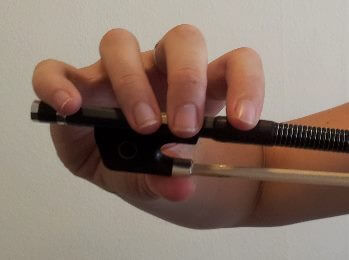 The violin bow hold was dependent on the musical purpose and the type of bow. Throughout the centuries we can distinguish two schools of bowing: French and Italian. They both had their own development until they merged in the 18th century.
The violin bow hold was dependent on the musical purpose and the type of bow. Throughout the centuries we can distinguish two schools of bowing: French and Italian. They both had their own development until they merged in the 18th century.
French violin bow hold until 1600
The thumb was held under the hair. As it wasn’t possible to tighten the bow with a screw, the violinist would tighten the hair with his thumb while playing. This bow hold was used most in dance music using short bows.
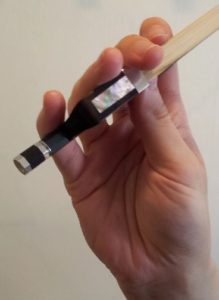 Italian violin bow hold until 1600
Italian violin bow hold until 1600
In the Italian bow hold the thumb was held between the bow and the hair, like we do now. They had longer bows and played more developed music.
The place of the hand on the bow varied. Sometimes the bow was held near the frog and sometimes more in the middle. This depended on the player, the length of the bow and the balance.
Is this an interesting read? Share this article on Twitter and look smart 🤓
Violin bow hold between 1600 and 1650
For the knowledge about violin bows from the beginning of the 17th century we mostly depend on paintings and drawings. One can wonder how reliable this is as a resource, given the painter most of the times wasn’t a violinist. The bows themselves were badly conserved.
We know the bows were relatively short, certainly those used for dance music. They were hardly longer than the violin itself, so a bit more than half the modern violin bow.
The violin bow varied greatly in weight, flexibility and stiffness. Not much was standardized and there were big differences between countries and makers.
Please know that the French and Italian schools were widely spread and certainly not limited to France and Italy. Dance music violinists in Italy played with a French hold for example. The bow hold was related to the type of music and bow.
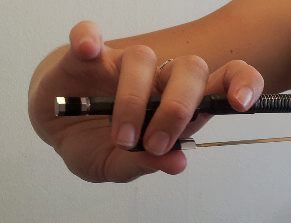 Bow holds weren’t standardized at all: it wasn’t even unusual to bow with the left hand.
Bow holds weren’t standardized at all: it wasn’t even unusual to bow with the left hand.
French violin bow hold 1600-1650
The bow hold was rather tensed in these days as the thumb was still used to tighten the bow hair.
The bowing technique wasn’t very subtle or nuanced and aimed at the rhythmical and highly articulated (percussion like) playing needed in dance music. Yup, those baroque fiddlers liked to swing!
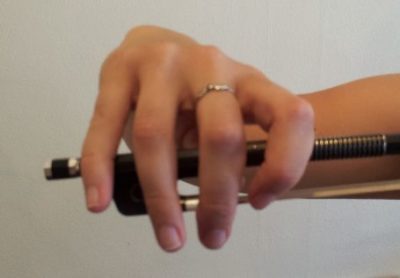 Italian violin bow hold 1600-1650
Italian violin bow hold 1600-1650
The Italian bow hold was the basis for further development in violin playing and bowing technique, that flourished in Italy.
In contrary to the French bow grip, the Italian grip was more suitable for subtle bow technical variations and more advanced violin techniques. The sonata players used the Italian bow hold.
Improve your violin bowing technique
Enjoy my FREE mini Masterclass 5 Bowing Secrets to Create a Professional Sound on the Violin
Violin bow hold between 1650 and 1700
This is a very interesting era as the contributions of different countries to violin music started to differ very much. In violin virtuosity and playing technique Germany surpassed Italy. In Italy the emphasis lied more on developing musicality, composition and tonality instead of instrumental technique.
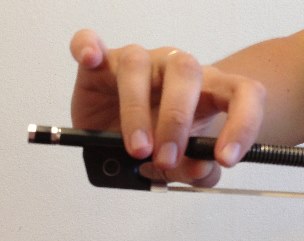 Bow holds didn’t change much. The French hold with the thumb below the hair lost it’s popularity and the Italian hold with the thumb between the stick and the hair became more and more standard.
Bow holds didn’t change much. The French hold with the thumb below the hair lost it’s popularity and the Italian hold with the thumb between the stick and the hair became more and more standard.
When the famous violinist and composer Matteis came to England in the early 1670’s, he taught his violin students to hold the bow just at the stick and not at the hair,
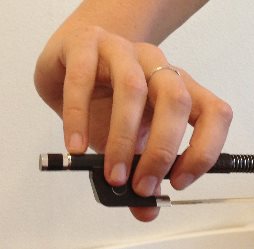 The violinist Flack promoted the French hold, firmly gripping the hair with the thumb creating a deep bowing and tone. He taught that the index finger should touch the stick around the top joint (see picture) and one shouldn’t bow too much near the bridge. In his time the bow was mostly held higher up the bow and he taught to hold the bow at the frog as we do now.
The violinist Flack promoted the French hold, firmly gripping the hair with the thumb creating a deep bowing and tone. He taught that the index finger should touch the stick around the top joint (see picture) and one shouldn’t bow too much near the bridge. In his time the bow was mostly held higher up the bow and he taught to hold the bow at the frog as we do now.
Violin bow hold between 1700 and 1761
In the beginning of the 17th century the bow developed itself faster than the violin itself. First there was a distinction between the long Italian bow meant for sonata playing and the short French bow meant for dance music. Around 1720 this changed, because of the emerge of the sonata school amongst French composers and players.
The violin bows became straighter and longer. They looked very elegant. Some already show a preparation to the curve of the Tourte bow. The bow tips start to look more and more like the one we use now instead of the ‘fluted’ baroque bows used until then.
The bow hold developed alongside the violin hold. As the violin was first carried on the arm with the scroll pointing downwards, violinists started holding the violin under their chin and kept the violin itself more up straight. This allowed more virtuosic playing.
In the beginning of the 17th century the French hold was a common bow hold. After 1750 the French hold became all-together redundant amongst professional players with the emerge of sonata playing. In more informal dance music amongst more ‘common fiddlers’ the French hold remained.
The Italian hold became the standard and the only one written about in literature, like the book by Corrette. Was was not standardized is where to hold the bow: at the frog of further in the direction of the tip. It depended on the balance of the bow.
Want to learn more about violin playing before 1761? I can recommend this book.
Bow hold according to Leopold Mozart
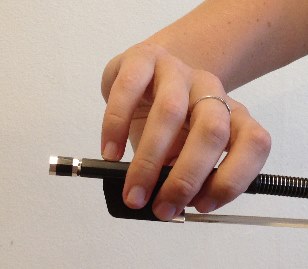 In his book from 1756 Leopold Mozart (yup, the father of…) describes that the bow should be held at the frog between the middle phalanx of the index finger and the thumb. The fingers should be held relatively close together. The pinky shouldn’t leave the bow in any circumstance, as it contributes to bow control and determines the weight in the bow stroke. The index finger shouldn’t be placed too much over the bow and shouldn’t be too far removed from the other fingers. Stretching the index finger over the bow is a grave error and stiffens the hand. The hand should do most of the work when creating a soft sound. The bow should be pivoted slightly in the direction of the scroll.
In his book from 1756 Leopold Mozart (yup, the father of…) describes that the bow should be held at the frog between the middle phalanx of the index finger and the thumb. The fingers should be held relatively close together. The pinky shouldn’t leave the bow in any circumstance, as it contributes to bow control and determines the weight in the bow stroke. The index finger shouldn’t be placed too much over the bow and shouldn’t be too far removed from the other fingers. Stretching the index finger over the bow is a grave error and stiffens the hand. The hand should do most of the work when creating a soft sound. The bow should be pivoted slightly in the direction of the scroll.
Sounds all very familiar, doesn’t it?
Violin bow hold between 1750 and 1800
The bow hold described by Leopold Mozart seems surprisingly modern. You wouldn’t expect the changes that were about to happen.
In this era the design of the bow was mostly standardized by Tourte. This meant that the bow hold didn’t have to adjust to developments in violin bow design. Click here to read more about the history of violin bows.
Hiller
In his book from 1793 Hiller took an example from Leopold Mozart. The difference is that he instructs to put the bow straight on the string, instead of pivoting it, so you bow with all the hair and achieve a bigger tone.
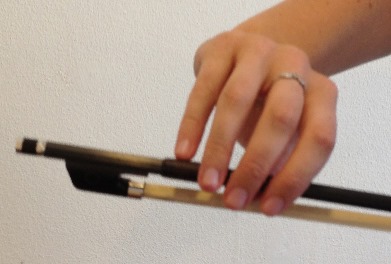 Campagnoli
Campagnoli
Campagnoli based his violin bow on the one described by Geminiani: an Italian hold a bit further on the stick, not at the frog (see picture). The first phalanx of the first, second and third fingers rest on the bow. The pinky was stretched and placed on the bow. The thumb was curved and the fingers are placed close together.
Baillot, Rode and Kreutzer
In the book ‘Méthode de Violon’ (1802) the bow hold was described as follows: the stick is carried by all fingers. The thumb is placed against the frog opposite the middle (third) finger. The index finger rests with the second joint on the stick and joins the other fingers in a natural posture.

Hi! I'm Zlata
Classical violinist helping you overcome technical struggles and play with feeling by improving your bow technique.
Violin bow hold between 1800 and 1900
The days of the great virtuoso players!
Violin technique developed at a fast pace, but not much violin methods were developed to teach it. Virtuoso players had their own ways that they developed intuitively. One explained the unique technique as a sign of genius.
Old German violin bow hold
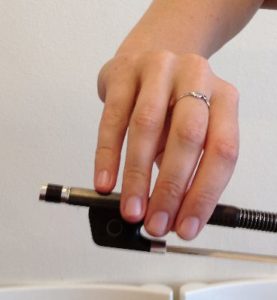 In ‘The Art of Violin Playing’ Carl Flesch describes old and new bow holds. One of them is the old German bow hold, where the index finger touches the bow between the first and second phalanx, so the first joint. The thumb is placed opposite the middle finger, balancing the weight. The other fingers are held relatively close together. As you see in the picture, the fingers are placed not much over the bow. This is caused by the placement of the index finger. The fingers are more stretched than curved. The hold looks more edgy than round.
In ‘The Art of Violin Playing’ Carl Flesch describes old and new bow holds. One of them is the old German bow hold, where the index finger touches the bow between the first and second phalanx, so the first joint. The thumb is placed opposite the middle finger, balancing the weight. The other fingers are held relatively close together. As you see in the picture, the fingers are placed not much over the bow. This is caused by the placement of the index finger. The fingers are more stretched than curved. The hold looks more edgy than round.
If you try this, you’ll notice it feels very unstable.
Franco Belgian violin bow hold
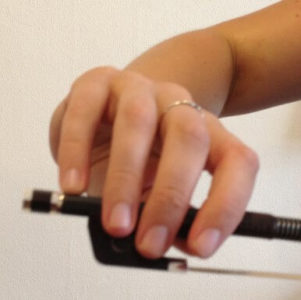 In this bow hold the index finger is placed sideways on the stick right before the first joint. The hand is placed a bit more in the direction of the tip. When you do this, you’ll feel more control over the bow. Also you’ll be better able to transfer weight into the bow. By spreading the fingers a bit more you can transfer even more weight. The fingers are placed more over the bow, as the position of the index finger allows this. This hold looks rounder and gives you more ‘grip’ in general.
In this bow hold the index finger is placed sideways on the stick right before the first joint. The hand is placed a bit more in the direction of the tip. When you do this, you’ll feel more control over the bow. Also you’ll be better able to transfer weight into the bow. By spreading the fingers a bit more you can transfer even more weight. The fingers are placed more over the bow, as the position of the index finger allows this. This hold looks rounder and gives you more ‘grip’ in general.
This hold is very similar to the hold mostly taught today.
New Russian violin bow hold
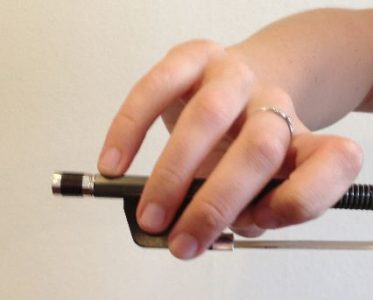 At first Flesch preferred this hold (before the modern hold developed). The index finger is even further over the bow compared to the old German and Franco Belgian bow holds. The stick touches the third phalanx of the index finger. The index finger embraces the bow with the second and third phalanx. The index finger and middle finger are close together.
At first Flesch preferred this hold (before the modern hold developed). The index finger is even further over the bow compared to the old German and Franco Belgian bow holds. The stick touches the third phalanx of the index finger. The index finger embraces the bow with the second and third phalanx. The index finger and middle finger are close together.
In this Russion bow hold the hand it tilted in the direction of the tip more. We call this pronation. The bow strokes are led by the index finger. The pinky has less to do: it’s placed on the bow when bowing with the lower half of the bow and can leave the bow when bowing with the upper half. In playing the pinky often leaves the bow. This hold is the basis of the modern bow hold and still used today by those taught in the Russian school of violin playing.
Modern violin bow hold
This is the bow hold as taught and used today. However, of course the bow grip is something highly personal and you’ll notice differences between players. No use in copying me or anyone else exactly ;). Here’s mine JUST for reference:
Development in violin bow grip
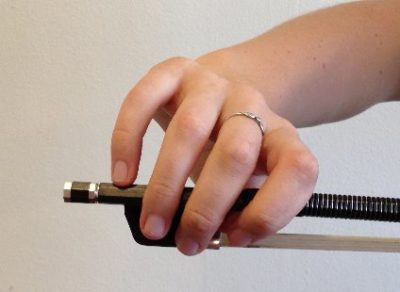 As you take a look at the three last bow holds described above, you might notice that the index finger is placed more and more over the bow and the hand is tilted more and more in the direction of the tip (pronation).
As you take a look at the three last bow holds described above, you might notice that the index finger is placed more and more over the bow and the hand is tilted more and more in the direction of the tip (pronation).
The advantage of this is that you can transfer more weight into the bow creating a deeper sound and you experience more control over the bow. This was required to create a powerful tone in the concert halls that got larger and larger.
Just give those three bow holds a try and see what happens to your sound and bow control!
In the modern bow hold the index finger is placed on the stick just before the second knuckle. The thumb is placed opposite the middle finger.
This gives you the best flexibility and control to…
Move your bow hold along with the bow strokes
By the way the fingers are placed, you can tilt the hand in the direction of the tip on the up bow (pronation) and release that on the down bow (supination). Your wrist turns in the direction of the bow stroke. Your hand turns around the center point of your middle finger and thumb. You’re constantly balancing the weight to the movement of the bow.
The thumb is the counter player of the other fingers, just as it is in your left hand technique
The challenge is to make smooth and relaxed movements, but still maintain the contact points. The bow movement and sound are more important than how your bow hold looks. Here are some tips on smooth bowing.
Reading all this you might think:
‘Ok, Zlata, I just spend quite some minutes of my valuable practice time on reading your stuff… What’s the point?’
With a modern bow hold and a modern bow you play music throughout four centuries
Creating a historically informed sound (sort of)
The tone before 1750 was clear, transparent and well articulated. This was different than the romantic 19th century ideal of a more deep sustained tone.
Baroque violins sounded less intense, less thick and with more ‘air’. The tone was nuanced and not so sustained.
Baroque bowing technique
With the bows back in those days it wasn’t possible to get a full sound right away. You’d press the bow in the string during a short bow stroke and release it. The ideals of the silent bow change and whole bow bowing didn’t exist yet. Lifting the bow a bit creates a 17th century staccato that sounds similar to our ‘modern’ spiccato.
Of course this all differs depending on what you play: a dance, a sonata or a concerto.
Keep this article in mind when you’re playing classical music.
Curious about the 24 different bowing techniques used today? Click here to read and watch all about them.
Remind yourself what gear the players back in those days used, what the possibilities were and how it all sounded
You can discuss whether you want to sound exactly as the players did back then (historically informed performance) or whether you just want to create the same meaning and the same mood translated to the modern ear and ideal (romantic playing style).
It might be interesting to try some historical bows to get the feel
Or… try out some bow grips and hold your bow higher up the bow, so it feels lighter like the shorter and lighter bows back then. You’ll quickly notice you can’t make sustained long notes with a deep sound and will start using a more catchy articulation to convey musical meaning.
Make sure to try the French bow hold. Hold the bow with the thumb under the frog, so the bow seems to be in your fist. Your wrist can’t move, think about having to tighten the hair with your thumb and make firm and short bow strokes.
Play around with all this and let me know in the comments what your findings are!
I’m very curious if this article changes the way you play.


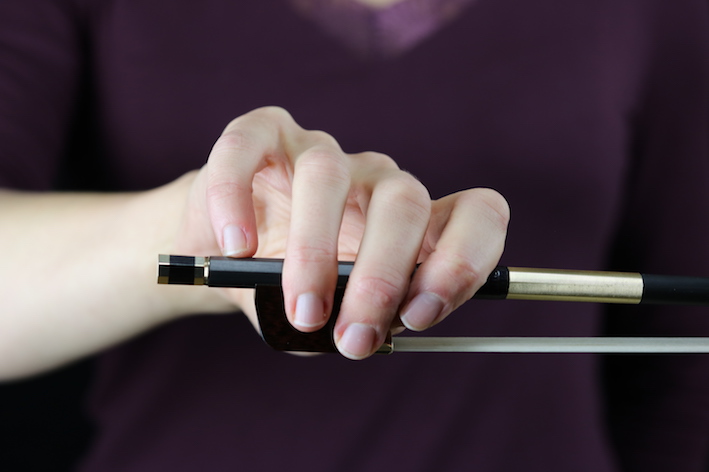
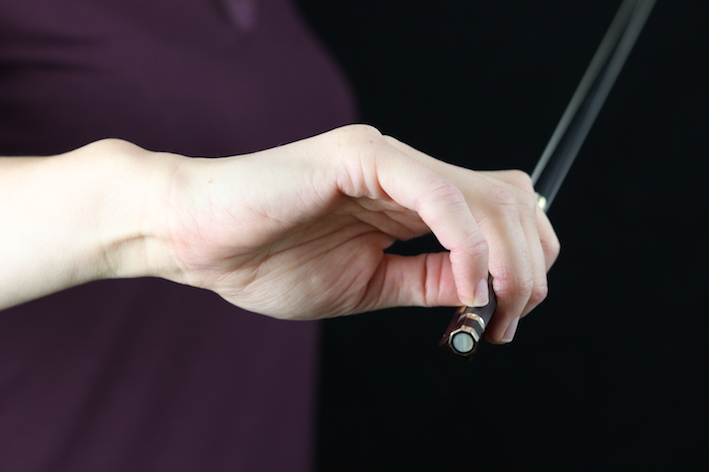
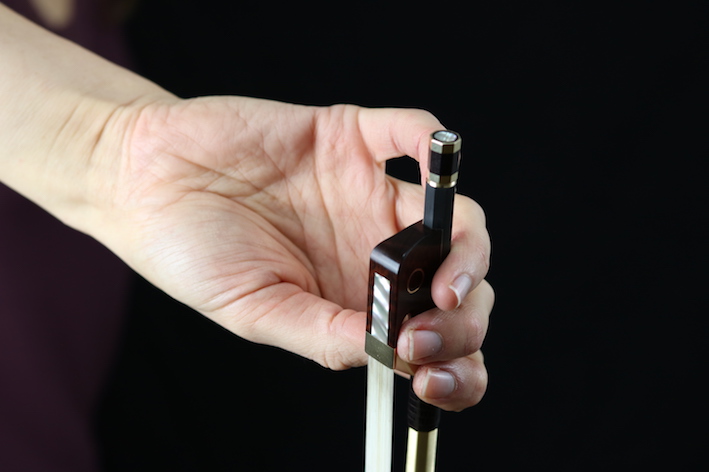
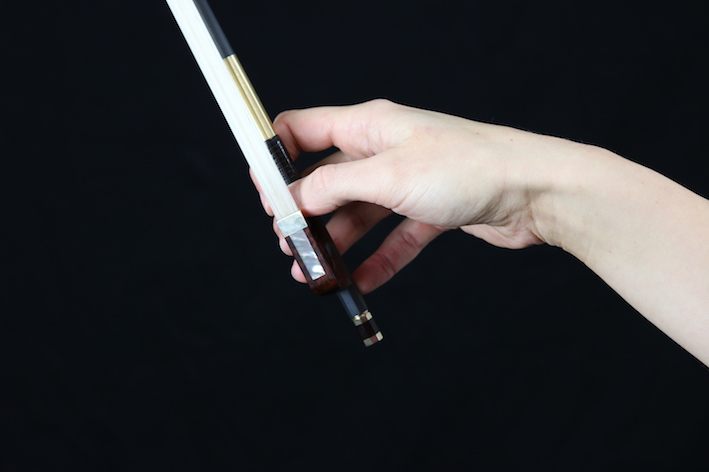
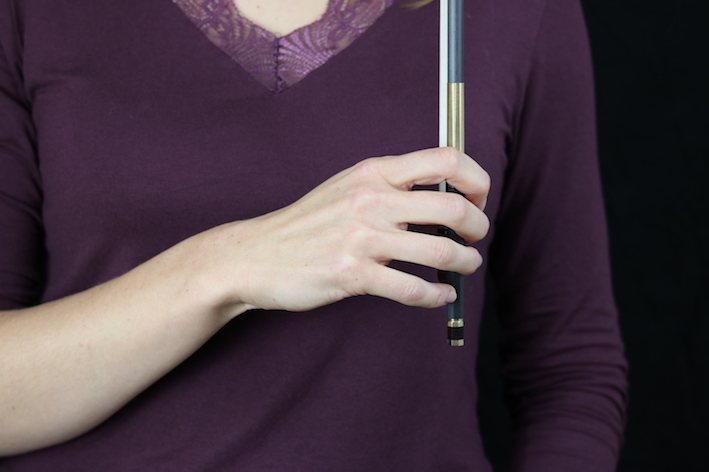
Hello Zlata. Thank you for writing this article. It is very detailed, which makes it so fascinating to read. I find history helps expand understanding.
I will now start going through the hyperlinks for even more information. I value the insight and preparation you share with us! I’ll try the bow holds too! Just want to thank you again. SJB
Yay, thanks for reading, Sarah, great to read it’s useful :).
Thanks Zlata, I like this article very much because you are explaining many things I did not know before. Very interesting to see the evolution of bowing. I would love to jump in a time-machine now and than to hear the original sounds. We have in our minds that the original sound would be the best but I am not sure if I see how they were using bows, even tighten the hair with the thumb when playing. I have learned a lot in 20 minutes!!!
Good to read that, Thisbe!
Amazing information
Thank you
Glad it’s interesting! 🙂
Thank you for all this information, Zlata! As a beginner, I struggle with my bow hold and arm movement, which screeches horribly! Seeing you hold the bow in the pics helps me a lot!
And learning more history about this fascinating musical instrument is fun, too!
Great! Also check out this video.
I always enjoy your articles Zlata.
I am also glad you are able to take time with your family. For families [not including financially of course] this is a good time for them as they have so much time together. Hopefully it helps to make them stronger. 🙂
Thanks again for this article. 🙂
Yes, that’s definitely true!
I love it Zlata. More Power to you. Stay safe
Take care, Michael!
Hi, Zlata. Thank you for an interesting article on the historical development of the bow hold. I was taught to use the Franco Belgian hold. It is comfortable and gives me a nice level of control over my bowing. I hope your family and you stay well.
Glad it’s interesting! Yes, the Franco Belgian or modern bow hold is what most players use today. Take care, Thomas!
Zlata you have “wet my whistle” for more information. This bow development, and hence it’s use and hold, to suit various music styles is really a matter of practical function. A viola da gamba player once explained to me that the underhanded bow hold they use, with what we know as a baroque bow, results in their up bow being equivalent to a cellist down bow. You have to try it to believe it, and then you do (you can try this on a violin with a modern bow). The thumb tension control is also revealing before we had the screw adjustable frog or nut. I shall have to reread your discussion a dozen more times. I especially appreciate the way you divided it into 50 year periods, a nice frame of reference. There has always been confusion on the Russian vs German vs Franco-Belgian bow hold, and you cleared that up for us nicely and in fine detail. Love your clear discussions. Please keep you and your family safe and always keep your wonderful positive attitude.
Thank you, John, glad this is interesting! Take care! 🙂
Interesting information. However, I noticed that some violin prodigies like Chloe Chua seem to hold their fingers more on top of the stick than on the side of the frog. Her bow often looks like it’s tilted almost horizontally. What bow hold is this?
Apart from these bow holds we have individual differences per player and it also depends on the bow technique you’re playing at that moment.
I have come across a picture of a string quartet where the fiddle players hold the bow with the pinky inserted between the stick and the hair! This was a folk group in Gozo more than 100 years ago. So I am calling this the Gozitan bow hold. Also, all four players in the picture are smoking! I tried to attach the picture but couldn’t.
Haha, sounds like a very interesting pic!
Hi, I played the violin (very very basic) far too many years ago than I care to remember (if I had to give a number 30 ish ha ha)
since I’m stuck at home with the current situation we find our selves, and my photography business is on a stand still, in thought I’d have a go at taking it up again. I know videos on line aren’t the best place, but at present it’s all I can do. I’ve just started a Skill share course.
With regards to holding the bow. my little fingers are bent and curve inwards to the other fingers if that makes sense, making it hard to bend at the knuckle comfortably. it feels easier to stretch it out towards the screw so it is straight. and somewhat tense. I’m guessing this is an improper technique, but would this cause any issues in playing etc?
Best wishes
stay safe
simon
Yes, that’s easier, but as you’re not actively using your pinky, it can’t perform the function it as in smooth bowing, bow control and in the future more advanced techniques like spiccato. This warm up will help you for sure!
Ganassi played the viola da gamba and the recorder. His is not the only work. Bows were not considered disposable. There was no standard grip in the renaissance and baroque, but there are some detailed descriptions, see for example Matteis.
Hi Zlata! Would yo mind citing your sources for this article? Thank you!